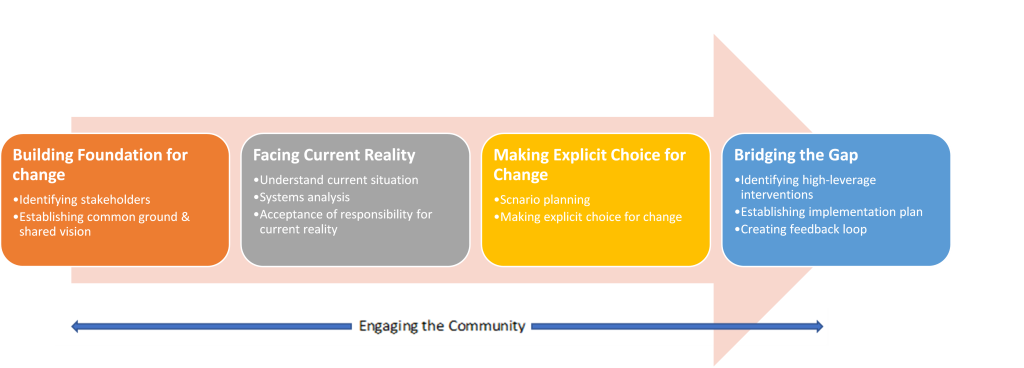12 Engaging Collaborators
“Creating space to tell disability justice stories and telling disability justice stories is a way that we remake the world, and it’s a way that we do disability justice activism because we are creating space to show different ways to be disabled, sick, neurodivergent, and deaf people of color. We are creating space for other disabled Black and brown queer folks to be like ‘Oh my God, that’s my story,’ or ‘That’s part of my story, and I can tell it, and I can ask for what I need, and I can create the movements that are gonna save my life, that aren’t gonna leave me behind.'”
Leah Lakshmi Piepzna-Samarasinha, on Disability Justice[1]
As you begin to engage with key stakeholders in your community, you also need to identify the key organizations and people who are also invested in solving or addressing the same problems that you are focused on. If you work with these organizations beyond the initial engagement stage, you will need to consider them as collaborators and create space to engage in this work together.
To work in collaboration means that you are engaging and working with two or more other organizations on the same issue or problem. You are all invested in the work and recognize that there is a benefit to working together.
Working in collaboration is not easy, and is often not very efficient. But, it is necessary and inevitable because there is almost always more than one organization that is invested in addressing similar issues. Collaboration can be done informally and with short-term expectations, or it can require a formal structure for a longer-term commitment.
Strategic Collaboration
- To collaborate is to work strategically with others towards a common goal. Collaboration is necessary, optimal, and possible.
- The key is that the work is strategic; the collaborators are stakeholders and have a responsibility to work on the goal, vision, and support.
- Successful collaboration works to address issues at the root, rather than addressing just the symptoms of the root cause.
Systems Thinking for Community Change[2] provides a model for working collaboratively on the numerous complex issues or problems impacting our communities.

No matter the length of commitment, to work effectively in collaboration, you need to consider the following:
- The people and organizations invited to the collaboration should have a vested interest in addressing a community issue or situation.
- They likely witness the evidence of the problem.
- They likely contribute in some capacity to the problem.
- The issue or situation may keep them from realizing their mission.
- They are willing to do some work as part of the collaboration.
- The size of the collaboration should be small enough to be nimble but diverse in perspective.
- The collaboration should be willing and able to dissolve when it is no longer necessary or effective in its current structure.
- The facilitator is there to help the collaborators move through the community change process and should be all of the following:
- An effective communicator
- Able to engage in systems thinking in order to help the collaboration move forward in their strategic thinking and steps (i.e. use iceberg metaphor)
- Willing to ask the collaboration challenging questions
- Prepared to establish agendas, document the meeting decisions, conduct research, and establish a structure for information sharing
- The collaborators should function as a core team while regularly learning from community stakeholders
- Engage data and wisdom (within and outside the collaboration) to understand the context in which the issue or situation takes place (social, political, economic, etc.).
- Engage diverse stakeholders early to gather insights into how they are impacted by the issue or situation.
- Engage diverse stakeholders to hear their ideas for solutions, without constraints.
- The collaborators need to be willing to change and participate in intervention feedback loops
- Be willing to engage with their own agencies/organizations to identify the benefits and costs of change
- Be open to mindset shifts
- Be honest about limitations and constraints
- Be willing to participate in or support new interventions, knowing some will fail or need to be modified in order to be successful
- Hannabach, Cathay. (Host). (2018, May 2). Leah Lakshmi Piepzna-Samarasinha on Disability Justice (62) [Audio podcast episode]. In Image Otherwise. Ideas on Fire. https://ideasonfire.net/62-leah-lakshmi-piepzna-samarasinha-part-2/. ↵
- Stroh, D.P. (2015). Systems thinking for social change: A practical guide to solving complex problems, avoiding unintended consequences, and achieving lasting results. White River Junction, Vermont: Chelsea Green Publishing. ↵